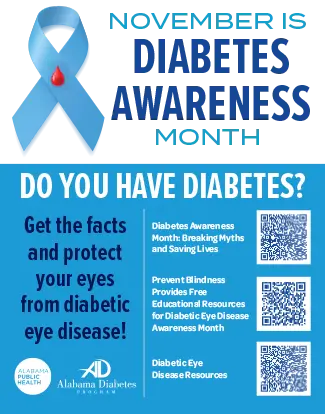
- Diabetes Home
- News and Events
- General Information
- Nutrition and Recipes
- Are You At Risk?
- Prevention
- National Diabetes Prevention Program
- Diabetes Self-Management Education and Support
- PPOD
- Marketing Materials
- Related Links
- Media
- Medical Waste Disposal
- Diabetes Today Sites
- Grant Opportunities
- Contact Us
SEE ALSO:
Cardiovascular Health
Nutrition and Physical Activity
NEED HELP?
Having trouble finding what you are looking for? Use our A to Z Index.
News and Events
Diabetes Awareness Month
 Did you know that, in Alabama, 15.7% of the adult population is living with diabetes? Click on the flyer to learn more about the resources available to you.
Did you know that, in Alabama, 15.7% of the adult population is living with diabetes? Click on the flyer to learn more about the resources available to you.
To find out if you are at risk of developing type 2 diabetes, take the online Prediabetes Risk Test.
If you have prediabetes, you can make healthy changes and prevent type 2 diabetes. The Alabama Department of Public Health can help you come up with a game plan to make healthy changes by joining a Lifestyle Change Program. Watch this video and take a sneak peek into the Lifestyle Change Program. Visit the Alabama Chronic Disease Resources Directory for a list of places that offer Lifestyle Change Programs in your area.
Do you have diabetes? Do you want to improve your blood sugar levels and keep your blood pressure on target? Then Diabetes Self Management Education and Support (DSMES) can help. Like many people living with diabetes, you may find managing diabetes is difficult. That’s where having a game plan with a coach can help by working with you to design a specific plan that includes the tools and support you need to thrive. Diabetes education helps people lower their blood sugar, blood pressure, and cholesterol levels. Visit the Alabama Chronic Disease Resources Directory for a list of places that offer DSMES.
Like everyone, people living with diabetes can get sick even when trying their best to prevent it. So being prepared and knowing what to do if you get sick is very important. The Centers for Disease Control and Prevention (CDC) has a list of several things you can do now, but also talk to your doctor about the best way to handle being sick if it happens.
People living with diabetes can have an eye disease such as diabetic retinopathy, cataracts and glaucoma. See your ophthalmologist regularly for dilated eye exams. The American Academy of Ophthalmology has information about detection and treatment of diabetic eye disease.
Foot problems are common in people with diabetes. You might be afraid you’ll lose a toe, foot, or leg to diabetes or know someone who has, but you can lower your chances of having diabetes-related foot problems by taking care of your feet every day. The National Institute of Diabetes and Digestive and Kidney Diseases has some useful tips to avoid foot problems.
Have you gotten your flu shot? People living with diabetes (type 1 and 2) are at high risk of serious flu complications. The CDC recommends that people with either Type 1 or Type 2 diabetes, who are 6 months and older, get a flu vaccine.
Diabetes Statistics Report
The CDC/Division of Diabetes Translation (DDT) prepares the National Diabetes Statistics Report, which provides the state of diabetes in the United States through analyses of the most recent health data on diabetes and related complications.
As of the most recent available data, 38.4 million Americans (11.6% of the population) live with diabetes.
Read the National Diabetes Statistics Report here.
Visit Media and Related Links for a variety of resources on preventing and managing diabetes.
Page last updated: October 30, 2025
SEE ALSO:
Cardiovascular Health
Nutrition and Physical Activity
NEED HELP?
Having trouble finding what you are looking for? Use our A to Z Index.




